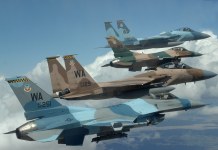The Chinese Navy ‘confronted’ the Australian Navy in the South China Sea (SCS). The confrontation took place last week near the Spratly Islands at a time of heightened diplomatic tensions between Australia and China.
The ABC first reported that Australian warships encountered the Chinese navy during a voyage that included travel close to the Spratly Islands, although it was believed the Australian ships did not go within 12 nautical miles of the contested islands.
The Australian Defence Force joint task group consisting of five ships, HMAS Canberra, Hobart, Stuart, Arunta and Sirius, was travelling through the area last week on the way to Hawaii for joint military war games with the US and Japan in the Philippine Sea.
India Bets Big On Nikki Haley To Emerge As Vice Presidential Candidate Under Trump
As reported by EurAsian Times earlier, Australia, Japan and the United States conducted a trilateral military drill in the Pacific Ocean in a show of solidarity against Chinese aggression in the South China Sea.
Australia has downplayed the incident and according to the Defence Department all “unplanned interactions with foreign warships throughout the deployment were conducted in a safe and professional manner”.
Tejas vs J-20: How Chinese J-20 Jets Have Overpowered Indian LCA Tejas With Indigenous Technology?
Despite the latest ‘confrontation’, Prime Minister Scott Morrison said Australia would continue to adopt a very supportive position of freedom of navigation in the SCS.
The South China Sea is a key naval passage linking Asia with Africa and Europe. As estimated $3.37 trillion of international trade passes through the SCS and it is believed to be abundant in untapped natural resources such as oil and gas.
China has claims to 80% of the SCS. It is also claimed by Vietnam, Philippines, Indonesia, Malaysia and Brunei.
Relations between Beijing and Canberra have hit rock bottom ever since Australia called for a Covid-19 inquiry. Irked, China retaliated by blocking beef imports from four abattoirs, imposing new customs requirements on Australia’s iron ore and levying a 40 per cent tariff on Australia’s barley exports.
Since then, Australia and China have had a disagreement over new security law in Hong Kong. Canberra has offered to settle Hong Kongers leaving Hong Kong. In response, China has lashed out at Australia and warned of “huge impact” to the Australian economy, if the Government pushes ahead with a plan.
Why India Went Running To Russia After The Deadly India-China Border Clash At Galwan Valley?
Australia finds itself in a tough spot. While it trying to stand up to a bullying China, it cannot afford to irk Beijing since China is its biggest trade partner. At the same time, Australia wants to continue robust defence relations with the US and counter an aggressive China.




